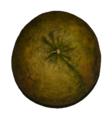The pomelo (Citrus maxima or Citrus grandis) is a crisp citrus fruit native to South and Southeast Asia. It is usually pale green to yellow when ripe, with sweet white (or, more rarely, pink or red) flesh and very thick albedo (rind pith). It is the largest citrus fruit, 15–25 centimetres (5.9–9.8 in) in diameter,[1] and usually weighing 1–2 kilograms (2.2–4.4 lb). Other spellings for pomelo include pummelo, and pommelo. An alternative name is shaddock.
The pomelo is native to Southeast Asia[2] and is known there under a wide variety of names. In large parts of South East Asia, it's a popular dessert, often eaten raw sprinkled with or dipped in salt mixture. It is also eaten in salads or together with yoghurt, and sometimes pickled.
The pomelo tastes like a sweet, mild grapefruit (which is itself a hybrid of the pomelo and the orange[3]), though the typical pomelo is much larger in size than the grapefruit. It has very little, or none, of the common grapefruit's bitterness, but the enveloping membranous material around the segments is bitter, considered inedible, and thus usually is discarded. The peel is sometimes used to make marmalade, can be candied and sometimes dipped in chocolate or, in China, is used in stir fries with pork [4]. Pomelos are usually grafted onto other citrus rootstocks, but can be grown from seed, provided the seeds are not allowed to dry out before planting. The seedlings take about eight years to start blooming and yielding fruit[citation needed].
The etymology of the word "pomelo" is uncertain. It is thought to perhaps be an alteration of pampelmoes ("shaddock") or alternatively, perhaps an alteration of a compound of pome ("apple") + melon.[5]
The town of Tambun in Perak, Malaysia is particularly famous for pomelos.[citation needed] The two varieties are a sweet kind, which has white flesh, and a sour kind, which has pinkish flesh and is more likely to be used as an altar decoration than actually eaten. Pomelos are a must during the mid-autumn festival or mooncake festival; they are normally eaten fresh.[citation needed]
In rural areas in Assam, children often use pomelos as footballs.[citation needed]
In Manipur, the fruit is used as a major source of vitamin C. This fruit holds a high place in the culture and tradition of Manipur.[citation needed]














0 komentar:
Posting Komentar